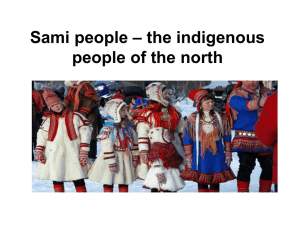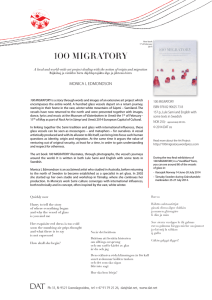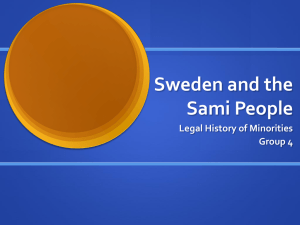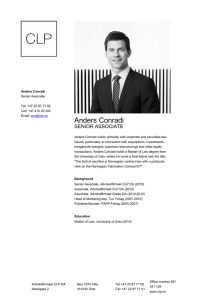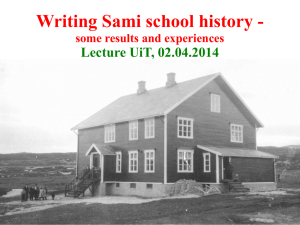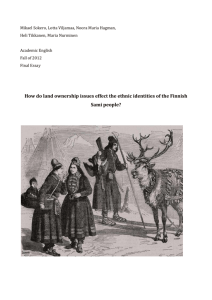Sami culture and language in the new teacher training
advertisement
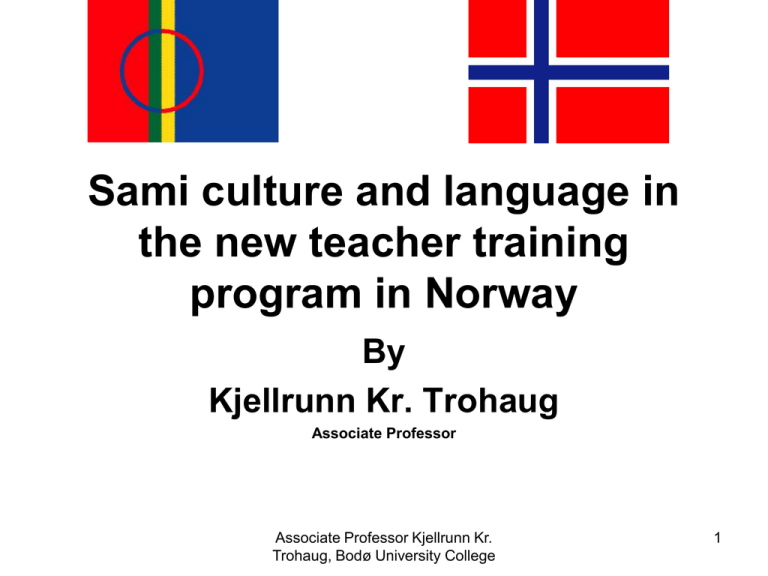
Sami culture and language in the new teacher training program in Norway By Kjellrunn Kr. Trohaug Associate Professor Associate Professor Kjellrunn Kr. Trohaug, Bodø University College 1 Sami culture and language • A part of the proposed new teacher training program in Norway. • How to teach the students through literary studies. • Reading fiction. Associate Professor Kjellrunn Kr. Trohaug, Bodø University College 2 Historical background • The state of Norway is founded on the territory of two nations: the Sami and the Norwegian. • Norway is a rather young nation, and gained its independence as late as 1905. • Until then, the region had been in a continuous union with Denmark, and then with Sweden. Associate Professor Kjellrunn Kr. Trohaug, Bodø University College 3 Building a Norwegian Nation • A by-product of this building of a nation was the oppression of the indigenous Sami culture and language. • For more than 150 years, the official Norwegian policy favoured ethnic Norwegian culture and language, and oppressed the Lappish culture, in order to build an independent, Norwegian nation. Associate Professor Kjellrunn Kr. Trohaug, Bodø University College 4 ILO Convention 169 • Concerning indigenous and tribal peoples in independent states. • According to this convention, • the Sami are an indigenous people, not an ethnic minority. • There are five defined ethnic minorities in Norway, according to this definition: Jews, Kvens (descendants from Finnish), Forest Finns in Solør, Roma, and Romani. • Newer immigrants are not indigenous peoples according to international law. Associate Professor Kjellrunn Kr. Trohaug, Bodø University College 5 Curriculum of the teacher training program • Norway is preparing a new, national teacher training program, launched in the autumn of 2010. • Ministry of Education and research. • The Sami parliament has agreed on the importance of knowledge about the Sami culture and language for the students. Associate Professor Kjellrunn Kr. Trohaug, Bodø University College 6 The earlier primary school curriculum • Only children of Sami birth or children in Sami districts had the right to learn about Sami culture and language at school (National curriculum of 1974 and 1987). • According to the national curriculum of 1997, all students, all over the country, are required to learn about the Sami people. • The Sami perspective has not been explicitly shown in the curriculum for the teacher training program. Associate Professor Kjellrunn Kr. Trohaug, Bodø University College 7 How to handle challenges of the new teacher training program • Study the national curriculum and the Sami children’s rights in the educational system – past and present. • Text readings – I will introduce a selection of Norwegian fiction to the students. • The students will study Sami life and civilization through these texts. • The Sami people as indigenous group. Associate Professor Kjellrunn Kr. Trohaug, Bodø University College 8 Method: How to train the students through literary studies • We will read closely a text corpus from the late 18- and 1900s. • Includes authors like Jonas Lie, Knut Hamsun, Johan Falkberget, Olav Duun and Regine Normann, which throw interesting light on our topics. • To study the texts with a view to the Sami: – 1) as individuals – 2) as a group Associate Professor Kjellrunn Kr. Trohaug, Bodø University College 9 Questions: • How can a diachronic study of a text corpus give the students knowledge of the cultural and historical background of the Sami students at the school? • Why do many Sami wish to hide their Sami background, even today? • How does the study of a fiction corpus help us explain such an attitude? Associate Professor Kjellrunn Kr. Trohaug, Bodø University College 10 Literary motifs in the text corpus • The motifs of cultural conflict – The contrast between Sami and Norwegian culture and language. • The motif of the nature child – The Sami as a child of nature. – The Norwegian as representing a civilized nation. The motif of love between a Sami person and a Norwegian. The motif of mixed blood – Can lead to unclear ethnic identity. Associate Professor Kjellrunn Kr. Trohaug, Bodø University College 11 Literary motifs in the text corpus • The motif of mixed marriage: – Marriage of Samis and Norwegians is not desirable. • The motif of Lapp magic: – The Sami are working magic and are spreading fear and terror. • The motif of conflict with industrialisation: – Conflict between keeping reindeer and agriculture on the one hand, – or keeping reindeer and the mining industry on the other hand. Associate Professor Kjellrunn Kr. Trohaug, Bodø University College 12 For our purposes • We will look at two central motifs – 1) The motif of mixed blood – 2) The motif of Lapp magic Associate Professor Kjellrunn Kr. Trohaug, Bodø University College 13 ”It is a shame to be of Lappish blood” Jonas Lie (1872): in the short story ”Lappish blood” • The young man Eilert thinks about his own identity as a Lapp: ”He had heard that it was a shame to be of Lappish blood, beause the Lapps were not as good as other people. The authorities allowed them burial only in particular areas of the church yard and special ’Lapp chairs’ in the church.” Associate Professor Kjellrunn Kr. Trohaug, Bodø University College 14 Mixed blood • Many characters in the text corpus are mixed people from mixed marriages. (Lappish-Norwegian) • Nonetheless, the local surroundings defined them as Lapp, e.g: – Aase in Knut Hamsun: The Road Leads On (1933) – Solvi in Olav Duun: The Blind Man (1919) – Jon in Regine Normann: Krabvaag (1905) Associate Professor Kjellrunn Kr. Trohaug, Bodø University College 15 How to hide Sami heritage? • The young man Jon in Regine Normann’s Krabvaag: – Is ashamed of his father being Lappish. – He dreams of America – in that country nobody knows about his father and his family, and cultural heritage. – Instead of accepting and facing his ethnic background, he wants to run away from it. Associate Professor Kjellrunn Kr. Trohaug, Bodø University College 16 Lapp magic in the texts • These Sami characters are all accused of practising magic power to cause: – Accidents and crop failures. – Storms and bad weather. – Illness and disease. • This interpretation of the events take it for granted that the surroundings accept and believe in the practice of magic. Associate Professor Kjellrunn Kr. Trohaug, Bodø University College 17 Summary • How can literary study emphasize the intentions of Sami awareness in the new teacher training program? • By reading these texts the teacher training students could better understand why: – the older generation of Sami tried to hide who they really were. – and why they disclaimed their own cultural heritage. Associate Professor Kjellrunn Kr. Trohaug, Bodø University College 18 The Creole Identity • ”In the multi-ethnic society, it is necessary to strike a balance between that which is in common and that which is different. It is necessary to remain conscious of the fact that each of us belong to many groups, and that there are many ways of combining identities. • Being a modern Norwegian Sami is one such identity, a traditional Norwegian farmer another, a postmodern Norwegian public relations consultant another, a modern Norwegian muslim another. • Therefore, the national community cannot just build on common values and cultural heritage. It must also build upon difference.” (Thomas Hylland Eriksen (1997): Flerkulturell forståelse, Tano Aschehoug) Associate Professor Kjellrunn Kr. Trohaug, Bodø University College 19 Then we can conclude • The political norwegian National building program of the 19th century is out of date and unacceptable (one people –one state) • A modern state has to build on differences not homogeneity • By reading fiction my students have been able to see the history of Sami identity – and to have a basis of working with Sami culture in the teacher training program Associate Professor Kjellrunn Kr. Trohaug, Bodø University College 20 Litterature • • • • • • • • • • • • Altern, Inger og Minde, Gunn-Tove: Samisk folkemedisin i dagens Norge, Rapport fra seminar i regi av Institutt for sosiologi og Senter for samiske studier, Tromsø 26. – 27. nov. 1998, Skriftserie – Nr. 9 Senter for samiske studier, Universitetet i Tromsø 2000 Borgos, Johan (1999): De er her ennå, Samisk historie i Vesterålen, Vesterålen Kulturutvalg Vesterålsmuseet Edvardsen, Edmund (1977): Nordlendingen, Pax Forlag Eriksen, Thomas Hylland (1997): Flerkulturell forståelse, Tano Aschehoug Fidjestøl m.fl. (1994): Norsk litteratur i tusen år, LNU/Cappeln Nergård, Jens Ivar (1998): Det skjulte Nord-Norge, Skarðhamar, Anne-Karin (2001): Litteraturundervisning Teori og praksis, Universitetsforlaget Trohaug, Kjellrunn (2000): ”Om det samiske perspektivet i norskfaget i L 97” Norsklæreren nr 1/2000 Fiction: Duun, Olav (1957): I blinda. Skrifter i samling Bind V, Olaf Nordlis Forlag og Johan Grundt Tanum, Oslo Hamsun, Knut (1933): Men livet lever Lie, Jonas (1891): Finneblod, frå Trold I-II (1891-92) Normann, Regine (1905): Krabvaag, i utgåve i Fonteneserien, Aschehoug, 1976 Associate Professor Kjellrunn Kr. Trohaug, Bodø University College 21

